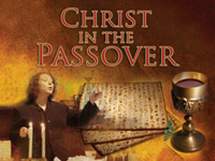
The Pesach is celebrated annually by the Jews to commemorate their deliverance from bondage in Egypt. After the Egyptian Pharaoh refused to let the Israelites travel to the Promised Land, God sent a series of plagues in order to force him to let His people go. The tenth and final plague involved the death of each firstborn male child in the land. At the Lord’s instruction however, the Israelite families sacrificed an unblemished male lamb and covered their doorposts with the lamb’s blood. Thus, when the Lord’s angel came, he “passed over” and spared those who were protected by the blood of the lamb. This account, recorded in Exodus 12, foreshadows how Jesus, our Passover Lamb (Jn 1:29, 1Cor 5:7) shed His own blood on the cross to protect all believers from spiritual death.
While Y’shua (Jesus) as the sacrificial lamb is the fulfillment of all the Passover represents as a whole, each individual portion of the ceremony also points to the Jewish Messiah. For example, just after the main meal, we come to the Afikomen (dessert) and the third of four cups, called the Cup of Redemption. The Afikomen consists of a piece of matzah (bread without chametz – “yeast” or “leaven”) that was broken off and hidden (Heb tzafun) before the meal for the children to search out and find after the meal. The eating of the matzah, representing the broken body of Christ, and the drinking from the cup, reminding us of His spilled blood, should be familiar to Christians. We perform this same ceremony when celebrating the Eucharist (or Communion), which Jesus instituted at the Last Supper (Lk 22:19-20). In addition, the hiding and bringing forth of the matzah pictures Jesus’ body being hidden in the grave, and His coming forth from the dead.
Whenever I see or participate in a Seder, as element after element continues to paint a clear picture of Christ, I always ask myself, why can’t our Jewish friends see this? (Of course, we can also ask the same question of non-Jewish unbelievers concerning God’s other revelations). We could offer many theological answers, but I like to suggest a couple of practical reasons. First, many Jews are cultural rather than religious Jews. That is, they go through the steps because of tradition, without even understanding the Jewish meaning of the ceremonies.
Second, for those who are religious Jews, most believe that being Jewish or being a Christian is mutually exclusive. In other words, by becoming a Christian, they are no longer Jewish. Nothing could be further from the truth. Jesus was a Jew. The first Christians, including all the writers of the NT (with the possible exception of Luke) were Jews. To accept the Jewish Messiah Y’shua as one’s personal Savior makes one a complete and fulfilled Jew.
Before I end this post, I’d like to say a big “Thank You” to the folks over at Plano Bible Chapel who hosted this event. PBC is a friendly and growing church in East Plano (Texas). I thoroughly enjoyed meeting and speaking with Pastor Larry, who made my wife and I feel right at home. The true church is one body with Christ as the head, but the Scriptures also place great importance on the local assemblies. Our first loyalty (after Christ of course) should be to our home church, but I also enjoy and even benefit from visiting other churches once in a while. It’s always amazing to see the different ways that God is working through various people. I was especially impressed by PBC’s commitment to the historical doctrines of the Christian faith, which have been pushed aside by many churches in a misguided attempt to be “more relevant” to modern society. It was also exciting to see the many missions in which the church is involved, including support for the Jewish people. While the mega-churches receive most of the Christian press, God is doing many great things in the smaller churches. I look forward to returning again soon.